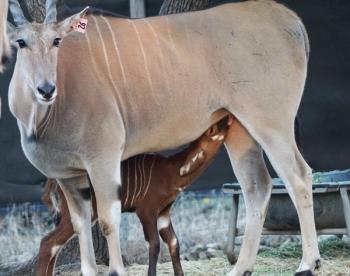
Is beta-carotene an essential nutrient?
Of the major carotenoids, ?-carotene has the highest pro-vitamin A activity.
Ãeta-carotene (Ã-carotene) is one of many carotenoids found in nature. In the human nutrition field, evidence suggests that higher blood levels of Ã-carotene, as well as other carotenoids such as alpha-carotene, lycopene, lutein, zeaxanthin and Ã-cryptoxanthin might be associated with lower risk of several chronic diseases. Ã-carotene, alpha-carotene and Ã-cryptoxanthin have pro-vitamin A activity, while the other carotenoids have no pro-vitamin A activity (DRI, 2000).
suggested reading
Earlier publications on nutrient requirements of horses (NRC, 1961) suggests that horses had both a carotene and vitamin A requirement; however the latest edition (NRC, 1989) has published only a vitamin A requirement and not a carotene requirement for all horse classes. Thus, nutritionists typically do not consider the intake of carotenoids when formulating rations for horses.
Do all horse classes only need pre-formed vitamin A and not Ã-carotene, or is there also a need to supplement some classes of horses with Ã-carotene as well as vitamin A?
What are carotenoids?
Carotenoids occur in almost all plants and animals. Carotenoids are essential to green plants for photosynthesis, acting in light harvesting and protecting against destructive photo-oxidation. Without carotenoids, photosynthesis in an oxygen-containing atmosphere would be impossible. In addition to those in green plants, carotenoids are also compounds easily recognized as the orange-red colors of foods, such as oranges, tomatoes and carrots. Some animals use carotenoids for coloration, especially birds (yellow and red feathers, e.g. flamingos), fish (e.g. goldfish and salmon) and a wide variety of invertebrate animals (shrimp, lobster and other crustaceans), where binding with protein can modify their colors to blue, green or purple.
Straub (1987) described 563 different carotenoids, not counting their various cis- and trans-isomers. A few of the main carotenoids and polyenes found in foodstuffs and feeds are alpha- and Ã-carotene, zeaxanthin, lutein, Ã-Apo-8;-carotenoids, Ã-cryptoxanthin, astaxanthin, canthaxanthin, citranaxanthin, lycopene, neoxanthin, phytoene and phytofluene and violaxanthin. The naturally occurring carotenoids are fat-soluble and are completely insoluble in water. They are often associated with lipids, to which they impart their color, e.g. milk fat, egg yolks and animal fat. In fish and shrimp, however, carotenoids are typically protein-bound.
Of the major carotenoids, Ã-carotene has the highest pro-vitamin A activity, thus it has received most attention by scientists. More recently, protective effects against serious disorders, such as cancer, heart disease and degenerative eye disease, have been recognized for Ã-carotene and the carotenoids lutein, lycopene and zeaxanthin. Roles other than pro-vitamin A activity have stimulated intensive research into various effects of carotenoids in humans and animals. Of the commercially available carotenoids, Ã-carotene is the least expensive.
Ã-carotene absorption, transport and tissue retention
Like other fat-soluble nutrients, Ã-carotene must be emulsified prior to metabolism and/or absorption via the action of bile acids. -carotene either can be converted in the mucosa to retinal by the action of a specific enzyme—15,15'-dioxygenase, and subsequently reduced to retinol, or it can be absorbed intact and incorporated in the chylomicrons. The Ã-carotene then is transported via the lymph into the blood. In either case, Ã-carotene or vitamin A then must be incorporated into chylomicrons and passed into the lymphatics. There are no data in horses, but in humans, 60 percent to 75 percent of the Ã-carotene is absorbed as vitamin A, while 15 percent is absorbed intact (Goodman et al. 1966). Ã-carotene is transported in the blood exclusively via lipoproteins, predominantly by low-density ones (LDL). Ã-carotene is excreted in the urine and bile.
Yang and Tume (1993) suggested that differences in the selective absorption process in the small intestine are responsible for the various concentrations of carotenoids observed in different species of animals. It is generally thought that carotenoids move into the enterocytes by passive diffusion (Furr & Clark, 1997). If this is the case, then species differences in intestinal pH, gut motility, liposome and micelle formation, as well as the variation in the type and amount of dietary fat consumed, might influence carotene absorption. In addition, little is known about how carotenoids are incorporated into lipoprotein fractions and enter the circulation (Furr & Clark, 1997). Species variations in lipoprotein handling are also likely to be large contributors to differences in the accumulation of carotenoids (Slifka et al. 1999).
Horses and certain breeds of cattle have the ability to absorb Ã-carotene intact as well as be converted to vitamin A (Bondi & Sklan, 1984; Parrish et al. 1947; Vander Noot et al. 1964). This conversion appears not to be very efficient in horses, and differences in utilization of carotenes from various forages can occur (NRC, 1989).
The utilization of Ã-carotene is dependent on the animal species and on the carotene and vitamin A supply status. In ruminants, with a vitamin A supply approximately covering the requirement, a conversion rate of Ã-carotene to vitamin A of 6:1 (1.8 µg of Ã-carotene provides 0.3 µg of vitamin A alcohol = 1 IU of vitamin A) can be assumed. The conversion is similar for horses: 1mg Ã-carotene provides 333 IU vitamin A activity (Fonnesbeck and Symons, 1967).
Measuring tissue concentration, horse-related species (Perissodactyla) had carotenoids ranging from not detectable in the black rhinoceros to 13 µg/dl in the Grant's zebra (Slifka et al. 1999). The serum concentration of Ã-carotene in the Grant's zebra was similar to the 14.6 µg/dl reported in horses by Baker et al. (1986) but was considerably lower than the 52.46 µg/dl value reported for horses by Vander Noot et al. (1964).
Functions and actions
For the horse, the main recognized function of is as a precursor to vitamin A. Through other actions, it can provide benefits other than a source of vitamin A, especially to those horses not consuming adequate Ã-carotene from green, lush pastures. Ã-carotene, like vitamin E, can serve as an antioxidant and enhance the immune system. It has been shown to enable immune cells to act more efficiently by increasing lymphocyte response to mitogens and to assist helper T cells and natural killer cells (Santos et al. 1996; Hughes et al. 1997; Kramer and Burri, 1997). Disease resistance also has been observed in animals with high circulating Ã-carotene levels (DRI 2000). Whether the action is due to the Ã-carotene-moiety or its conversion to vitamin A is still being debated.
Benefit to reproduction and lactation
In the horse and other species, Ã-carotene supplementation has been shown to enhance reproduction (Van der Holst 1984, Brief and Chew, 1985, Michal et al. 1994, Chew et al. 1994). Fertility, especially of females, can be improved through the consumption of adequate Ã-carotene. Reduced Ã-carotene intake occurs mainly when horses do not have access to feedstuffs containing high levels of Ã-carotene, such as lush, green grass. Confinement feeding and/or feeding Ã-carotene-low diets has been shown to reduce circulating levels of beta-carotene in animals. Ã-carotene supplementation was found to have a positive effect on fertility in cattle. Its deficiency resulted in higher incidence of silent estrus, decreased conception rates, increased embryonic death, early abortion and poor quality colostrum (Simpson & Chichester, 1981).
Pres et al. 1993 found that sows fed supplemental Ã-carotene had more piglets per litter, and synthetic -carotene in addition to vitamin A supplementation increased the number of viable embryos and corpus lutei in sows slaughtered on the 28th day of gestation. Moreover Ã-carotene subsequently improved the fertility of sows in the next reproductive cycle. Coffey and Britt (1993) reported that sows injected with various levels of Ã-carotene had decreased embryonic mortality and higher plasma Ã-carotene levels for up to 13 days post-injection. By day 18, there were no differences in plasma levels.
Iwanska and Strusinska (1997) suggested that Ã-carotene specifically, not as a precursor of vitamin A, was an important factor in bovine reproduction. They found that the number of inseminations per cow was reduced, and the conception rate was significantly higher in cows supplied additionally with 300 mg of synthetic -carotene with or without vitamins A, D3 and E.
Weng et al. 2000 found that Ã-carotene was taken up by canine blood, luteal and endometrial tissues in a dose-dependent manner, as had been shown in sows (Chew et al. 1994), and cows (O'Fallon & Chew, 1994). They suggested that Ã-carotene can be beneficial in optimizing the functional integrity of these tissues and as an antioxidant, it protects ovarian and endometrial tissues from oxidative stress. As the endo-metrium undergoes dramatic changes to ensure successful implantation and survival of the conceptus, Ã-carotene can act to decrease embryonic mortality. They stated, "Uptake of Ã-carotene by the uterine endometrium could protect the highly active uterine environment against oxidative damage, thereby ensuring a more optimal uterine environment for embryo development."
For horses, Van der Holst (1984) reported that Ã-carotene supplementation produced stronger heats, improved conception rates and tended to reduce embryonic mortality. Ferraro and Cote (1984) suggested that feeding 100 mg Ã-carotene/day induced earlier and stronger heats, improved conception rates, and aided in maintenance of pregnancy. Ralston et al. 1985 found that 17-19 mg Ã-carotene /kg DM in grass hay was adequate for semen production and libido in stallions.
Schweigert and Gottwald (1999) found that Ã-carotene concentrations in colostrum were correlated positively with corresponding plasma levels in mares during 12 weeks surrounding parturition. They suggested the possible reasons for the increase in plasma Ã-carotene around parturition may be an improved absorption of carotene and/or reduced conversion to vitamin A, as well as mobilization from tissue storages or a reduced uptake in tissues other than the mammary gland. Increased Ã-carotene in the colostrum would be favorable to enhanced immune status in the newborn foal. Mares readily pass significant amounts of -carotene to their offspring via the colostrum.
Intake and supplementation
To meet their needs, what is the daily vitamin A intake of horses grazing green pasture? The answer is zero! Unlike carnivores, grazing horses do not consume vitamin A per se. They consume Ã-carotene, which is converted to vitamin A (retinol) in the intestine. The Nutrient Requirement for Horses (NRC, 1961) noted a specific requirement for carotene, and those horses on grain and forage diets consume approximately 360 mg natural Ã-carotene per day. It stated that a horse at maintenance required 1.5 mg/100 lbs body weight, thus a 1,200-lb mare would require 18 mg Ã-carotene daily. A lactating mare required 7 mg Ã-carotene per 100 lb body weight; thus a 1,200-lb lactating mare would have a daily requirement of 84 mg Ã-carotene.
Horses on fresh green pasture typically consume Ã-carotene at much higher levels than horses consuming stored roughages. Ã-carotene also is found in yellow corn at much lower levels. It is rapidly oxidized by light and heat, and therefore cured and storage forages readily lose Ã-carotene content over time. After two years of storage, Ã-carotene content of hay declined to less than 10 percent of its original concentration (Waite and Sastry, 1949). If hay is rained on during curing, and drying time is extended, then further losses will occur. Ã-carotene content of fresh growing grass and alfalfa is 400-600 mg/kg DM, whereas content in alfalfa and timothy hay (US 1) is 40 and 20 mg/kg DM, respectively (NRC, 1989).
Ã-carotene intake also varies seasonally from a high level during early spring and summer, and in some climates during the fall, to a decline during winter that lasts until new plant growth begins. Garton et al. 1964 noted that plasma Ã-carotene concentration of mares was 7.9 µg/dl during the winter on hay, 114.1 µg/dl on early spring pasture with a subsequent decrease to 15.6 µg/dl during the following winter. They reported a mean concentration of summer and fall pastures of 204 mg/kg DM. Fonnesbeck and Symons (1967) found that Standardbreds consuming hay (Bromegrass, canarygrass, fescue, red clover and alfalfa) supplying 198 mg Ã-carotene per day did not maintain initial plasma vitamin A concentrations, which declined from 14.6 to 8.5 µg retinol/dl during a 24-week feeding period. Plasma Ã-carotene was very low and ranged from 1.9 to 8.5 µg/dl during the same time period.
Ahlswede and Konermann (1980) reported that horses on pasture had plasma carotene concentrations 8 times to 13 times higher than horses kept in stables, and that -carotene supplementation of stabled mares tended to improve ovarian activity. Other researchers (Mäenpää et al. 1988) found seasonal variation in vitamin A status, an indicator of seasonal Ã-carotene intake.
In a survey of pastured horses, Barton, 1997 (personal communication) found that serum Ã-carotene levels ranged from a low of 3.3 µg/dl to a high value of 293 µg/dl with an average of 55 µg/dl. In stabled horses, the range was 1.8 to 16 with an average of 8.4 µg/dl.
Griewe-Crandell et al. 1997 fed vitamin A and Ã-carotene-depleted mares either 72,000 I.U. vitamin A palmitate or 216 mg Ã-carotene /dl. utilizing a 10-percent water-dispersible beadlet equivalent to 72,000 I.U. vitamin A. They found that the beadlet form of Ã-carotene was poorly absorbed and did not improve vitamin A status of depleted mares. Ã-carotene concentrations in serum were found to be undetectable. Watson et al. 1996 also found poor availability from a water-dispersible beadlet when fed to Thoroughbreds and ponies. They found approximately 40 percent of the supplemental beta-carotene in the feces. Kienzle et al. 2002 fed approximately 225 mg Ã-carotene from a water-dispersible beadlet for four weeks. Plasma Ã-carotene levels increased from approximately 2.5 µg/dl to 30 µg/dl. These studies demonstrate the variation in the bioavailability of Ã-carotene products supplemented to horses.
Recommended Intakes
It should be kept in mind that Ã-carotene has pro-vitamin A activity to meet a horse's vitamin A needs, however if beta-carotene is needed for other metabolic purposes, vitamin A cannot meet those needs. The 1989 NRC's vitamin A requirement ranges from 30 IU/kg of body weight to 60 IU /kg BW. Guilbert et al. 1940 suggested that the minimal requirement of -carotene for horses could be defined as that level to prevent nyctalopia (night blindness) to be 20 to 30 µg/kg BW, that would be equivalent to 6.6 -10 IU vitamin A/kg BW. This level supported normal growth and freedom from signs of deficiency. The minimal carotene requirement for significant tissue storage and reproduction was raised to 125 µg/kg BW, but that level was based on research with other species besides horses.
In general, the supply of Ã-carotene appears to be adequate when horses are grazing lush pasture. Due to higher cost compared to vitamin A, Ã-carotene is not typically supplemented in horse diets. From review of the literature, breeding horses and foals in confinement or on poor winter pastures and fed stored forages could benefit from Ã-carotene supplementation.
From various horse studies, Ã-carotene has been fed at levels of 100 mg/day (Ferraro and Cote, 1984); 400 mg/day (Van der Holst, 1984; and 500 mg/day (Ahlswede and Konermann,1980; Eitzer and Rapp, 1985). While the NRC (1989) suggests that Ã-carotene supplementation is not beneficial to mares on pasture or fed forages containing high levels, it does suggest that the daily dietary requirement for Ã-carotene to supply vitamin A activity is 72-144 µg/kg BW.
Horses grazing lush pasture appear not to require additional Ã-carotene supplementation, no matter what their life stage or physical condition. However, young foals, yearlings and breeding animals not on pasture should be supplemented with 1,000 mg Ã-carotene per horse daily. Working performance horses and breeding stallions should be supplemented daily with 500 mg Ã-carotene. Since excess Ã-carotene supplementation has not caused any reported toxicities in horses, these recommended supplemental levels are well within safe levels (NRC, 1989).
Summary
Ã-carotene is a naturally occurring plant pigment readily obtained by horses grazing lush pasture. If a horse on pasture consumes 1.5-2 percent of its body weight as forage, then a horse (500kg) would consume about 3,000 mg natural Ã-carotene daily. The confined horse would consume about 300 mg.
Though its primary function is as the major pro-vitamin A source, as an antioxidant, Ã-carotene has been shown to enhance immunity and be beneficial to reproduction. It is found in abundance in the mare's colostrum and corpus luteum. There is also evidence it is beneficial for stallion fertility. Since all commercial sources of supplemental Ã-carotene are not equally bioavailable, it is important to supplement a horse with the most biologically absorbed source of Ã-carotene.
Because Ã-carotene is absorbed naturally with the aid of bile acids and micelle formation, micellized sources of Ã-carotene allow for more efficient absorption and uptake.
Newsletter
From exam room tips to practice management insights, get trusted veterinary news delivered straight to your inbox—subscribe to dvm360.






